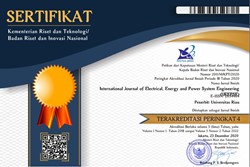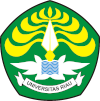Power Capacity and Speed Analysis for Elevator Motors at Madani Hospital Pekanbaru
Abstract
An elevator or elevator is a means of conveyance found in high-rise buildings to make it easier for people to move quickly to the desired floor. Currently, the motor that is widely used as an elevator driver is a three-phase induction motor. The output of this three-phase induction motor is in the form of torque to drive the elevator. Of course, the number of passengers carried by the elevator has a different weight so that it will affect the power and torque generated by the motor to transport these passengers. The method used in this study was to collect data in the form of data on the number of passengers and data on lift motors at Madani Hospital by observation. Then after the data is obtained, measurements and calculations are carried out to obtain the torque, power and speed of the elevator motor. The results of this study are with a passenger load of 0 kg, 196 kg, 678 kg, 891 kg and 1,122 kg, when the elevator goes up the more the number of passengers, the greater the power and torque of the motor. The magnitude of the motor mechanical torque needed to move between floors is the same, if the distance between the floors is the same. The addition of passengers does not affect the speed of the elevator motor because the elevator moves constantly.
References
Harahap, A., & Triyadi, S., “Elevator Systems (Standards and Details) for Architecture Students” (1st ed.), Deepublish, 2015.
Fahriansyah, A., Hartadi, B., & Herlina, F., "Planning of a Passenger Elevator with a Traction Type Drive System with a Capacity of 600 kg for the Needs of a Hospital Building Case Study at Sumber Jaya Sehat Kandangan Hospital", 2021.
Santosa, Y., & Febriansyah, D., "Analysis of Power Requirements for Passenger Elevator Motors Based on SNI No. 03-6573-2001, vol. 3, pp. 1-9, 2021.
Rahmadhani, R., Yahya, PS, Hartono, N., & Supriyo, “Moch. Ichsan Semarang City Hall, vol. 19, 2014.
Bagia, IN, & Parsa, IM, Electric Motors, CV, Rasi Rising, 2018.
Devianto, "Analysis of the Effect of Loading on the Electrical Parameters and Harmonics of a Three-Phase Induction Motor as a Driver for the Kauari Building Elevator PT. Muti Prada Mandiri, Semarang University, 2021.
Marsito, E., "Analysis of the Effect of Passenger Load on the Power and Energy Consumed by the Elevator Driving Motor in the IDB II RD Building. Dewi Sartika”, Jakarta State University, 2016.
Yuniaten, A., "Comparison of the Effect of Changes in Torque on the Power Factor and Efficiency of 3-Phase Induction Motors by Direct Testing and using ETAP", Sriwijaya State Polytechnic, 2017.
Firdaus, F., & Mukhlisah, S., "Motion of Objects and the Concept of Mechanical Energy", UMSIDA Journal, pp. 1-14, 2018.
Sulaiman, S., & Tegar, T., "Energy Needs in Making Particle Boards from Empty Palm Oil Bunches, Pine Bark Powder and Acacia", Rang Teknik Journal, vol. 2(2), pp 1-11. 2019.
Rahmansyah, A., & Satriadi, "Realization of a Three-Phase Induction Motor Control System Based on PLC Omron CPLE", University of Muhammadiyah Makassar, 2015.
Department of Public Works, “Components of Power Installation, Control, and Protection. In Field Supervisor Training for Installation of Elevator and Escalator Systems (SSLE)”, Construction Development Agency and Human Resources, 2006.
Copyright (c) 2023 Vicensia Lanisa, Antonius Rajagukguk

This work is licensed under a Creative Commons Attribution-NonCommercial 4.0 International License.


















